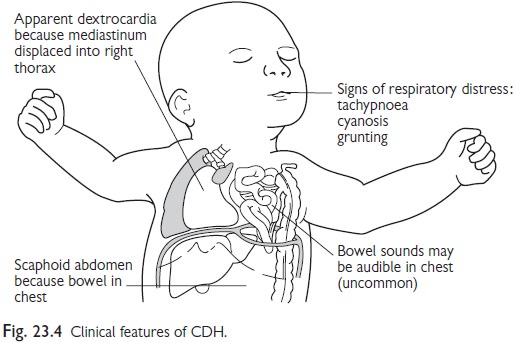Chapter: Paediatrics: Paediatric Surgery
Paediatrics: Congenital abnormalities: chest
Congenital abnormalities: chest
Congenital diaphragmatic hernia
The incidence of CDH is 1/2400.
The main problem is not the diaphragmatic hernia, but rather the associated
pulmonary hypoplasia that is often severe and determines prognosis. The most
common type of diaphragmatic defect is posterolateral (Bochdalek) and
left-sided, occur-ring in 90% (see Figs 23.3 and 23.4).


•
Antenatal screening: most CDHs are identified on
antenatal US, but the prognosis for
these foetuses is poor (i.e. 20% survive).
•
Birth: if the diagnosis is not made
antenatally and the baby presents at
birth, clinical findings may include respiratory distress, scaphoid abdomen,
and apparent dextrocardia. The prognosis for survival is 760%.
•
Coincidental: 710% of CDHs are discovered during
early childhood, including most
anterior (Morgagni) defects. The prognosis is excellent.
Neonatal management
•
Initial
management consists of sedation, paralysis, endotracheal intubation, and
mechanical ventilation with 100% O2.
•
NGT
placement and avoid bag–mask–valve ventilation.
•
If
oxygenation is good and pulmonary hypoplasia is not severe, repair of the
diaphragmatic defect is undertaken after a few days either by primary suture or
insertion of a prosthetic patch.
Hiatus hernia (HIH)

HIH refers to herniation of the
stomach into the chest through the oe-sophageal hiatus in the diaphragm. The
lower oesophageal sphincter also moves and becomes incompetent. Most children
with HIH present with gastro-oesophageal reflux (GOR). Two types of hiatus
hernia are recog-nized (Fig. 23.5):
•
sliding
(common);
•
rolling
or paraoesophageal (rare).
Management
•
Diagnosis
is made radiologically by barium meal.
•
Treatment
comprises management of the GOR, initially medically.
• Surgery is reserved for children who fail to respond to medication, complicated reflux (e.g. peptic strictures), and paraoesophageal hernias (because of the risk of incarceration and infarction of the herniated stomach). Surgery involves repair of the hiatus hernia and a fundoplication to prevent GOR.
Related Topics